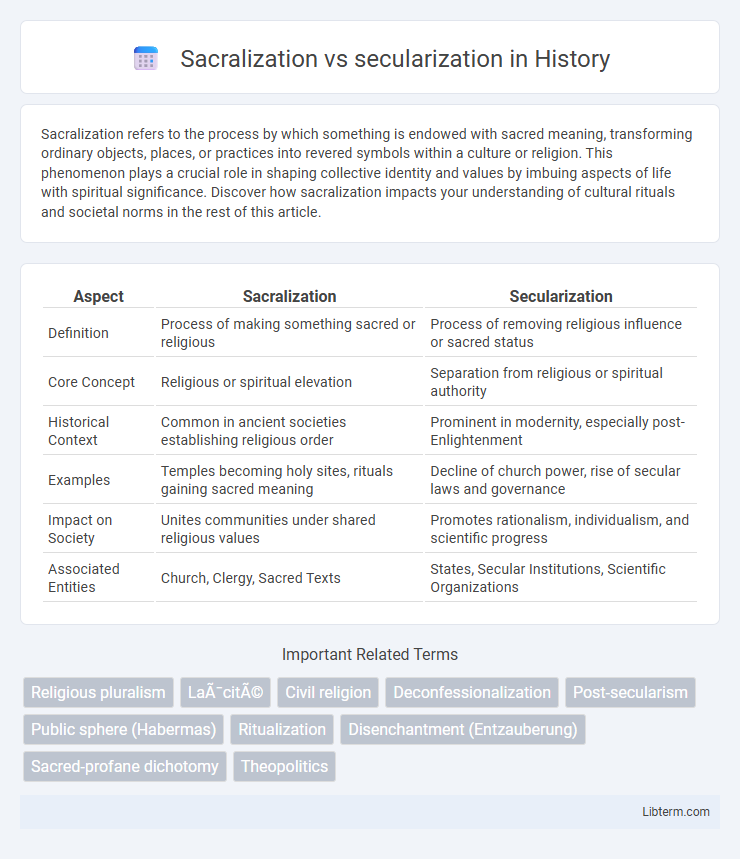Sacralization refers to the process by which something is endowed with sacred meaning, transforming ordinary objects, places, or practices into revered symbols within a culture or religion. This phenomenon plays a crucial role in shaping collective identity and values by imbuing aspects of life with spiritual significance. Discover how sacralization impacts your understanding of cultural rituals and societal norms in the rest of this article.
Table of Comparison
| Aspect | Sacralization | Secularization |
|---|---|---|
| Definition | Process of making something sacred or religious | Process of removing religious influence or sacred status |
| Core Concept | Religious or spiritual elevation | Separation from religious or spiritual authority |
| Historical Context | Common in ancient societies establishing religious order | Prominent in modernity, especially post-Enlightenment |
| Examples | Temples becoming holy sites, rituals gaining sacred meaning | Decline of church power, rise of secular laws and governance |
| Impact on Society | Unites communities under shared religious values | Promotes rationalism, individualism, and scientific progress |
| Associated Entities | Church, Clergy, Sacred Texts | States, Secular Institutions, Scientific Organizations |
Understanding Sacralization and Secularization
Sacralization refers to the process through which objects, ideas, or social practices are endowed with sacred meaning, transforming ordinary elements into symbols of religious or spiritual significance. Secularization involves the diminishing influence of religion and sacred authority in public life, leading to the separation of religious institutions from governmental, cultural, and social spheres. Understanding sacralization and secularization provides critical insight into how societies negotiate the balance between spiritual beliefs and secular values in shaping cultural norms.
Historical Roots of Sacralization
The historical roots of sacralization trace back to ancient civilizations where religious authority was intertwined with political power, legitimizing rulers as divine or semi-divine figures. In societies such as Mesopotamia, Egypt, and medieval Europe, sacralization manifested through rituals, sanctified laws, and institutions that reinforced the sacred status of kingship and governance. This fusion of sacred and political realms shaped the social hierarchy and cultural norms, profoundly influencing the development of state structures and religious traditions.
The Rise of Secularization in Modern Societies
The rise of secularization in modern societies reflects a decline in the influence of religious institutions and beliefs on public life, politics, and education. Increasing scientific advancements, urbanization, and emphasis on individual rationality contribute to the separation of religion from societal governance and cultural norms. As a result, secular values such as human rights, democracy, and freedom of expression increasingly shape legal frameworks and social behaviors across diverse nations.
Key Drivers Behind Sacralization
Key drivers behind sacralization include cultural revival movements, the search for identity amid globalization, and the rise of political ideologies that integrate religion into governance. Social instability and economic uncertainty often prompt communities to turn toward religious values for meaning and cohesion. The influence of charismatic religious leaders and the use of media platforms also play significant roles in promoting sacralization trends globally.
Social and Cultural Impacts of Secularization
Secularization transforms societies by diminishing religious authority and influence over social institutions, leading to increased individual autonomy and the rise of scientific rationalism. This shift fosters cultural pluralism, where diverse beliefs coexist and traditional religious norms lose predominance in shaping moral values and laws. As a result, secularization reshapes social cohesion and identity by promoting secular ethics and decreasing the interplay between religion and public life.
Case Studies: Sacralization in Contemporary Contexts
Sacralization in contemporary contexts manifests through various case studies, such as the resurgence of indigenous rituals in urban settings, which reinforces cultural identity and social cohesion. Sacred spaces like pilgrimage sites and heritage monuments are actively preserved and promoted to foster collective memory and spiritual engagement. These examples demonstrate how societies sacralize modern phenomena to maintain a sense of sacredness amid rapid secularization trends.
Secularization Trends Across Different Regions
Secularization trends vary significantly across regions, with Western Europe exhibiting pronounced declines in religious affiliation and church attendance, reflecting a shift towards secular values and institutions. In contrast, regions such as Sub-Saharan Africa and parts of Latin America maintain high levels of religiosity despite some urbanization and modernization pressures. Asia presents a mixed picture; while countries like Japan and South Korea show increasing secularization, others, including India, experience vibrant religious practices intertwined with cultural identity.
Interplay Between Religion and Secular Institutions
Sacralization refers to the process where secular institutions adopt religious symbols, values, or rituals, reinforcing spiritual significance within public life. Secularization involves the declining influence of religion in societal structures, promoting rationality and scientific principles over spiritual authority. The interplay between these forces shapes cultural norms, legal frameworks, and political discourse, reflecting ongoing tensions and integrations between sacred traditions and modern secular governance.
Future Challenges for Sacralization and Secularization
Future challenges for sacralization involve addressing the declining religious affiliation and increasing secular ideologies in urbanized societies, which threaten the role of sacred traditions. Secularization faces obstacles such as the resurgence of religious movements and the need to balance scientific progress with spiritual values in multicultural nations. Both dynamics require navigating the complex interplay between globalization, cultural identity, and ideological pluralism to shape social cohesion and policy-making.
Conclusion: Balancing Sacred and Secular Dynamics
Effective societal development requires balancing sacralization, which embeds religious meaning into cultural practices, and secularization, the process of minimizing religious influence in public life. Maintaining this balance ensures respect for spiritual values while promoting rational governance and social inclusivity. Understanding the interplay between sacred traditions and secular frameworks fosters cohesive communities adaptable to diverse beliefs.
Sacralization Infographic

 libterm.com
libterm.com